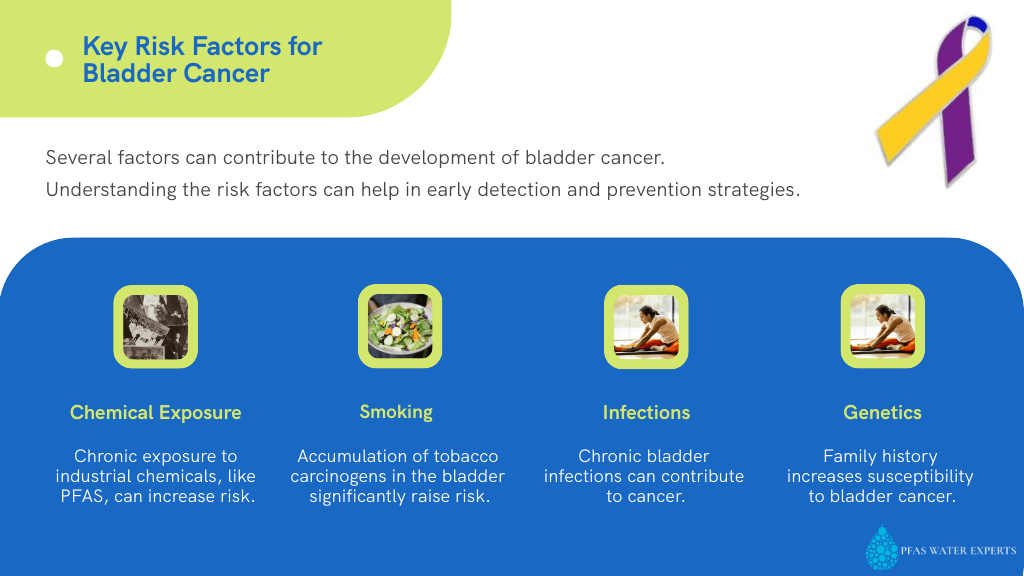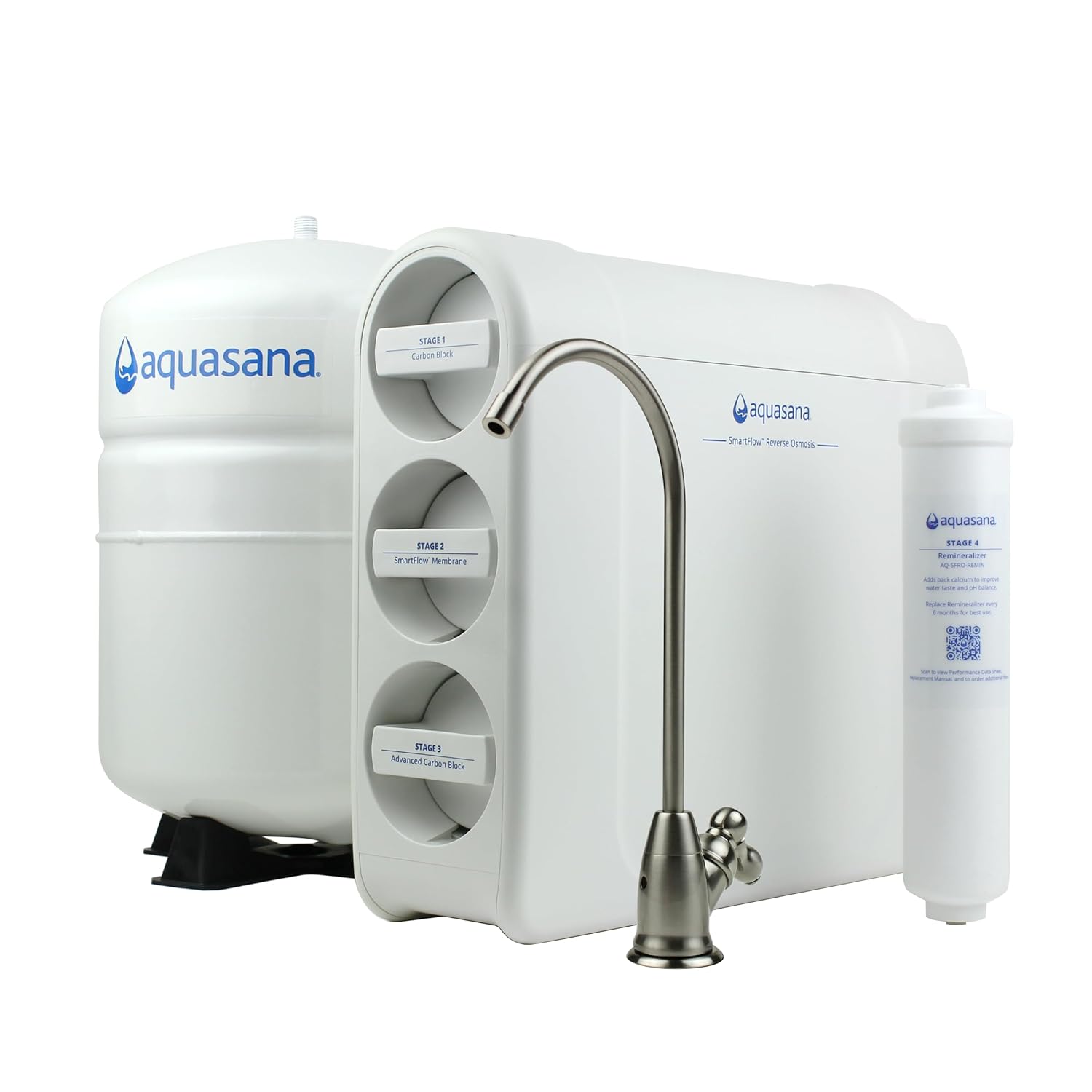Introduction
Per- and polyfluoroalkyl substances (PFAS) are synthetic compounds, widely used in industrial applications and consumer products and have been linked to numerous health problems, including cancers of the kidney, liver, prostate, and thyroid. Emerging research now suggests a strong association between PFAS exposure and bladder cancer, a malignancy that affects thousands of individuals each year.
Bladder cancer is particularly concerning because of its association with chemical exposure, given that the bladder serves as the body’s primary reservoir for filtering waste and harmful substances from the bloodstream.
This article examines the biological mechanisms through which PFAS may contribute to bladder cancer, reviews key epidemiological studies, and discusses public health implications and legal actions related to PFAS contamination.
Understanding Bladder Cancer
What is Bladder Cancer?
Bladder cancer occurs when abnormal cells grow uncontrollably in the bladder’s lining, forming tumors that can spread to surrounding tissues and organs. The disease is categorized into several types, including:
- Urothelial Carcinoma (Transitional Cell Carcinoma): The most common type, originating in the urothelial cells lining the bladder.
- Squamous Cell Carcinoma: A less common but more aggressive form, often associated with chronic irritation or infections.
- Adenocarcinoma: A rare form arising from glandular cells within the bladder.
Common Risk Factors for Bladder Cancer

- Chemical Exposure: Industrial chemicals, including PFAS, have been implicated in increasing bladder cancer risk.
- Smoking: Tobacco contains carcinogens that accumulate in the bladder, significantly raising cancer risk.
- Chronic Infections and Inflammation: Persistent irritation from infections or catheter use can contribute to tumor formation.
- Genetic Predisposition: A family history of bladder cancer increases susceptibility.
While these risk factors have been well-documented, recent research indicates that PFAS exposure may be a significant environmental contributor to bladder cancer development.
How PFAS Causes Bladder Cancer
1. Bioaccumulation in the Bladder
PFAS compounds are highly persistent in the human body, accumulating in various organs over time. Due to their chemical properties, PFAS are poorly metabolized and are primarily excreted through the kidneys into the bladder.
- Prolonged Exposure: Because the bladder serves as a storage site for urine, PFAS remain in direct contact with urothelial cells for extended periods before being expelled.
- Increased Absorption: Bladder tissues may absorb PFAS from urine, leading to cellular damage and genetic mutations.
2. Oxidative Stress and DNA Damage
PFAS exposure has been shown to generate oxidative stress, which can lead to DNA damage and mutations that contribute to cancer formation.
- Reactive Oxygen Species (ROS): Studies, including research published in Toxicological Sciences (2021), have demonstrated that PFAS exposure increases the production of ROS in bladder cells, causing oxidative damage.
- Impaired DNA Repair Mechanisms: PFAS interfere with normal DNA repair processes, allowing damaged cells to proliferate unchecked.
3. Disruption of Cellular Growth and Apoptosis
Cancer development often occurs when normal cell regulation mechanisms are disrupted. PFAS have been shown to interfere with these processes in multiple ways:
- Uncontrolled Cell Proliferation: A study in Molecular Carcinogenesis (2022) found that PFAS exposure led to increased expression of oncogenes, which promote tumor growth.
- Inhibition of Apoptosis: Normal cells undergo programmed cell death when they are damaged, but PFAS have been found to suppress apoptosis, allowing potentially cancerous cells to survive and multiply.
4. Endocrine Disruption and Hormonal Influence
While bladder cancer is not traditionally considered a hormone-related cancer, recent studies suggest that endocrine disruption may play a role in its development.
- Estrogen and Androgen Receptor Interaction: Research published in Endocrinology (2023) suggests that PFAS can mimic estrogen and disrupt hormone signaling, contributing to abnormal cell growth in bladder tissues.
- Inflammatory Pathways: Chronic inflammation induced by PFAS exposure has been shown to create a tumor-promoting environment within the bladder.
Studies Linking PFAS and Bladder Cancer
Several epidemiological studies have found strong evidence connecting PFAS exposure to increased rates of bladder cancer:
- Italian Chemical Workers Study (2021): Researchers in Italy studied workers in PFAS-manufacturing plants and found that individuals with prolonged occupational exposure had an elevated risk of bladder cancer compared to the general population.
- Swedish National Registry (2022): A study analyzing Sweden’s national cancer registry found that individuals living in municipalities with high PFAS water contamination had a significantly higher incidence of bladder cancer, particularly among older adults.
- North Carolina Community Health Study (2023): Conducted in areas affected by PFAS contamination from the Cape Fear River, this study found that residents with high PFAS blood serum levels had an increased risk of developing bladder cancer over a 10-year period.
- Denmark Military Base Study (2020): Research conducted on Danish military personnel exposed to PFAS-containing firefighting foam showed a notable increase in bladder cancer rates compared to non-exposed military populations.
Mitigating Exposure and Reducing Bladder Cancer Risk
Minimizing exposure to PFAS is an essential step in reducing the potential risk of bladder cancer. While complete avoidance of these chemicals is difficult due to their widespread presence, individuals can take specific measures to lower their exposure and protect their health.
1. Enhance Water Safety
- Invest in High-Quality Filtration Systems: Reverse osmosis filters and granular activated carbon systems have been proven effective in removing PFAS from drinking water.
- Check Your Local Water Supply: Communities near industrial facilities or military bases should routinely test for PFAS contamination through local water agencies or independent testing kits.
- Reduce Consumption of Unregulated Bottled Water: Some bottled water brands have been found to contain PFAS. Opting for home-filtered tap water can be a safer alternative.
2. Make Conscious Choices with Everyday Products
- Use PFAS-Free Cookware and Kitchen Items: Swap out nonstick cookware containing PFAS for stainless steel, ceramic, or cast iron alternatives.
- Avoid Stain-Resistant and Water-Repellent Textiles: Many outdoor gear, furniture, and carpets contain PFAS-based coatings. Look for brands that specifically label their products as PFAS-free.
- Choose Safer Food Packaging: Limit consumption of fast food and microwaveable packaged meals, as their packaging often contains PFAS to resist grease and moisture.
- Be Selective with Personal Care Items: Many beauty and hygiene products, such as waterproof mascaras, dental floss, and lotions, contain PFAS. Checking ingredient lists and opting for organic, PFAS-free alternatives can help minimize exposure.
3. Promote Health Monitoring and Preventive Care
- Regular Medical Check-Ups: Individuals who have lived in PFAS-contaminated areas or have known exposure should undergo routine screenings for early signs of bladder cancer.
- Stay Informed About Symptoms: Awareness of common bladder cancer symptoms—including blood in urine, frequent urination, and pelvic pain—can help with early detection.

- Maintain a Healthy Diet: Consuming antioxidant-rich foods, such as leafy greens, berries, and omega-3 fatty acids, may help counteract oxidative stress caused by PFAS exposure.
4. Advocate for Stronger Regulations and Corporate Accountability
- Support Legislative Efforts: Laws regulating PFAS use and contamination cleanup continue to evolve. Engaging with advocacy groups or contacting local representatives can contribute to stronger protections.
- Push for Transparency in Consumer Products: Increased demand for PFAS-free labeling on household and industrial goods can encourage manufacturers to seek safer alternatives.
The growing body of research linking PFAS exposure to bladder cancer highlights the urgent need for further scientific investigation, regulatory intervention, and public awareness. With PFAS persisting in drinking water, consumer goods, and occupational environments, individuals must take proactive measures to limit their exposure.
As awareness grows and additional research is conducted, stronger protections can be put in place to prevent future harm from these hazardous chemicals.








